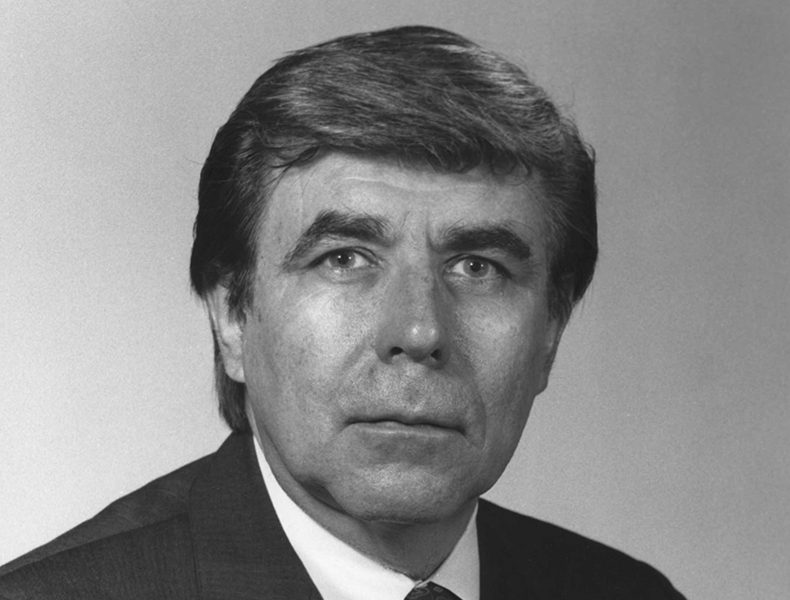Food Technology Magazine | Digital Exclusive
Remembering Ted Labuza
IFT looks back on Ted Labuza’s remarkable career in the wake of his death on Dec. 4.

Ted Labuza
Ted Labuza, an internationally recognized food scientist and past president of IFT, passed away on Dec. 4.
Earlier this year, around the time of a celebration of his life’s work held by colleagues at the University of Minnesota, he shared some of the highlights of his distinguished career with Food Technology.
In the program description of his retirement celebration, there is a mention of “Ted Labuza myths.” When asked about these myths, Labuza said there are a few that make him chuckle.
“I once received an email from a young scientist asking me to identify which Ted Labuza I was, as there must be several of them,” he said in an interview with Food Technology. “One person couldn’t have such an impressive publication record and be speaking at so many conferences and news media outlets. Did I have a twin, a clone, a father, or other relation who was also a food scientist?”
But, indeed, all of the accolades do belong to one man. Over the course of a 60-year career, Labuza, a past president of IFT, has authored and co-authored more than 280 scientific research articles, 18 textbooks, 78 book chapters, and eight patents. He was listed as one of six most highly cited scientists in agriculture and food science by the Institute of Scientific Information in 2002, and several lifetime achievement awards adorn his résumé.
Labuza recently celebrated his retirement at the University of Minnesota, where he was a professor for 50 years. He was joined by students, alumni, and colleagues to recognize his many contributions to the science of food.
Labuza first became involved with IFT as an undergraduate student at the Massachusetts Institute of Technology (MIT). It was 1960, and he was working toward his bachelor’s degree in food science and engineering. His professor, renowned food scientist and microbiologist Samuel Cate Prescott, was a founding member of IFT, and convinced Labuza to join the organization. He said it was “a given” that he would one day become a member.
While known for his work in food science and kinetics of reactions, Labuza said he didn’t originally plan to pursue studies in this area.
“As a freshman at MIT, I needed a job to support my education,” he explained. “I was very interested in nuclear physics, so MIT offered me a position to work in a research laboratory where early studies were being conducted on food irradiation. While working there, I met professors Sam Goldblith, Sandy Miller, Marc Karel, and Samuel Cate Prescott, all legends and giants in the field of food science and technology. I was inspired by them to become a food scientist.”
Labuza received his BS degree from MIT in 1962 and his PhD in 1965. He began his career as a researcher and professor at MIT before he began his tenure at the University of Minnesota in 1971. Throughout his career, he aimed to balance his time between the lecture hall and the lab.
“I tried to be dedicated to research, teaching, and service,” Labuza said. “Exceptional students were always my inspiration, as they challenged me with their unending questions, and I wanted to give them an answer.”
His research focused on the kinetics of reactions related to loss in food quality, nutrient degradation, and pathogen growth and death. In an article published in Food Technology in 2022, he discussed his research on water activity and how it can impact food packaging. Through this research, his team was able to predict food shelf life and water activity based on ingredients, temperatures, and the relationship between water and moisture contents.
Labuza said he has many memories of IFT, and it’s not easy to choose the ones that stand out.
“It’s difficult to choose just one,” he said. He counts “receiving my first undergraduate scholarship to being the recipient of the Nicolas Appert Award to being president during IFT’s 50th anniversary” among the highlights.
Labuza was named an IFT Fellow in 1979 and was elected president of the organization nearly a decade later. During his time as IFT president, he traveled all over the world meeting food scientists. He visited all 50 sections, including the four international sections: United Kingdom, Mexico, Japan, and Canada. Additionally, he wrote “Mission 2000: IFT’s Future” in the September 1989 issue of Food Technology, which served as a study to accelerate the development of IFT’s action plan heading into the 21st century.
“Six meeting were held in Minnesota during the summer of 1988 on my boat, known as ‘Water Activity,’ to focus on some key issues, such as how industry is changing, education, public outreach to the consumer, media, government policies, and governance of IFT,” he explained. “The ‘gold nugget’ was identification of the common grounds we all share. For example, one common ground was ensuring a high-quality education for the future leadership of the food sector with a continued focus on discovery and innovation.”
When looking ahead to the future, Labuza acknowledged that there are still unsolved challenges in the food supply. Not everyone on the planet currently has access to the proper nutrition.ft



